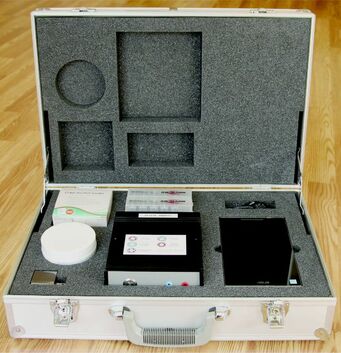First Generation Research Device: XCSITE 100
XCSITE 100 was a research grade tDCS/tACS device that enabled high-quality double-blind tDCS/tACS studies. XCSITE 100 was designed to meet the growing need for a device that could perform randomized, double-blind, placebo-controlled studies.
We are no longer selling the XCSITE 100, but we continue to support the researchers that do use it.
We are no longer selling the XCSITE 100, but we continue to support the researchers that do use it.
Your XCSITE 100 device is easy to use, cost-effective, and high-quality. In particular, the 1 button operation, together with user-friendly app, makes it easy for even new research assistants to perform transcranial electrical stimulation research.
-Current XCSITE 100 User
We had tried multiple different device platforms to initiate [our project] previously, and we're finally able to do our [study] because of the design philosophy of Pulvinar Neuro. It is unique and superior to your competitors.
-Current XCSITE 100 User
Publications
XCSITE 100 has been utilized in 8 peer-reviewed publications to date in indications including MDD, chronic pain, and substance use disorder, with more publications forthcoming.
- Riddle, J., et al., Reduction in Left Frontal Alpha Oscillations by Transcranial Alternating Current Stimulation in Major Depressive Disorder Is Context Dependent in a Randomized Clinical Trial. Biol Psychiatry Cogn Neurosci Neuroimaging, 2021.
- Ahn, S., et al., Identifying and Engaging Neuronal Oscillations by Transcranial Alternating Current Stimulation in Patients With Chronic Low Back Pain: A Randomized, Crossover, Double-Blind, Sham-Controlled Pilot Study. The Journal of Pain, 2018.
- Daughters, S.B., et al., Alpha-tACS effect on inhibitory control and feasibility of administration in community outpatient substance use treatment. Drug and Alcohol Dependence, 2020. 213: p. 108132.
- Ahn, S., et al., Transcranial Alternating Current Stimulation Reduces Network Hypersynchrony and Persistent Vertigo. Neuromodulation, 2021.
- Cha, Y.-H., et al., Remotely Monitored Home-Based Neuromodulation With Transcranial Alternating Current Stimulation (tACS) for Mal de Débarquement Syndrome. Frontiers in Neurology, 2021. 12.
- Ahn, S. and F. Frohlich, Pinging the brain with transcranial magnetic stimulation reveals cortical reactivity in time and space. Brain Stimul, 2021. 14(2): p. 304-315.
- Prim, J.H., et al., Targeting the Autonomic Nervous System Balance in Patients with Chronic Low Back Pain Using Transcranial Alternating Current Stimulation: A Randomized, Crossover, Double-Blind, Placebo-Controlled Pilot Study. J Pain Res, 2019. 12: p. 3265-3277.
- Cha, Y.H., D. Gleghorn, and B.C. Doudican, Double-blind randomized N-of-1 trial of transcranial alternating current stimulation for mal de debarquement syndrome. PLoS One, 2022. 17(2): p. e0263558.
CAUTION: Investigational Device. Limited by United States and EU law to investigational use.

